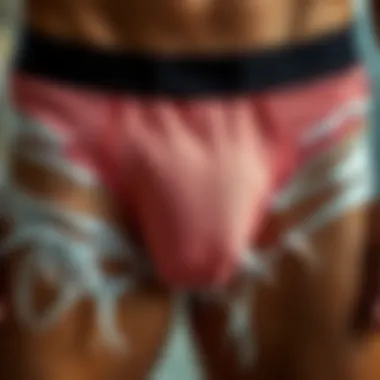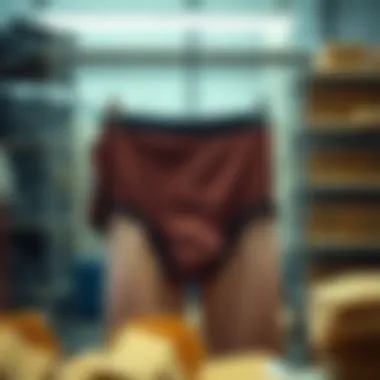Exploring Men's Ripped Underwear: Fashion Meets Function


Intro
Men's ripped underwear is not something that most people stop to consider. It's an element of fashion that seems to straddle the line between sheer absurdity and high style. Its increasing popularity raises a number of questions; is it pure fashion or is there a functional aspect to it? This article aims to dissect this intriguing trend, peeling back layers of history, culture, and practical use.
Ripped underwear has roots that extend far beyond mere trendiness. From punk rock icons sporting distressed fabrics to influencers flaunting their selection on social media, it’s a phenomenon that’s caught both eyes and conversations. Whether you're a fashion enthusiast, a retail aficionado, or a curious observer, understanding why ripped underwear has entered the male wardrobe is critical.
The symbolism of ripped styles varies widely. Some might see it as a declaration of rebellion, while others frame it as a comfort choice. Moreover, evaluating the interplay of fashion statements and practical needs shows a complexity that demands attention. With fabric choices ranging from breathable cotton to high-performance blends, ripped underwear is not just about aesthetics; it has to hold its own in terms of wearability and maintenance. As we dive deeper into this unique subject, we will cover the essential distinctions and cultural significances surrounding men's ripped underwear.
Clothing Trends
Seasonal Must-Haves
In today’s fast-paced fashion landscape, ripped underwear has emerged as a seasonal must-have for the modern man. Whether lounging around or gearing up for a night out, many men opt for these stylish alternatives. The spring and summer seasons usually see an uptick in demand as people look for fresh styles that dare to break traditional boundaries. On the other hand, versatile options featuring strategic rips can also find their place in winter wardrobes, layered under warmer clothing.
Iconic Styles Through Decades
Fashion trends often mirror cultural revolutions, and lacking the context renders them obsolete. Take, for instance, the 1980s punk scene, where shredded clothing echoed more than just a visual—it was a reaction to societal norms. Fast forward to today, and men's ripped underwear stems from that same spirit of rebellion, but it's also about modern aesthetics. The irony is that while ripped styles have a storied past, their current incarnation appeals to the broader male populace, from creatives to corporate types. That’s where the narrative gains traction; what was once exclusive is now embraced by many.
"Fashion is about more than just trends; it’s about telling a story."
Fashion Tips
Styling Essentials for Every Occasion
When incorporating ripped underwear into your daily ensemble, a few pointers can elevate the overall look. For a casual outing, consider pairing ripped underwear with looser-fitting shorts for an effortless vibe. If it’s a relaxed work setting, comfortable joggers complemented by ripped styles can strike the right note between comfort and professionalism. Fabric choice plays an important role in this scenario—cotton blends can be softer while moisture-wicking materials are perfect for active days.
Accessorizing to Elevate Your Look
Accessorizing can significantly influence how ripped underwear contributes to an overall appearance. A simple, understated belt can keep things polished while maintaining a casual air. Layering with a stylish long tee or tank can also tie the outfit together. The right accessories turn a potential misstep into a statement.
In the end, the continuing evolution of men's ripped underwear emphasizes not just a fleeting trend but a compelling intersection of style and function. As these garments spark various outlooks and inspirations, they compel us to reflect on their significance in contemporary menswear.
The Genesis of Ripped Underwear
The phenomenon of ripped underwear, specifically within men's fashion, is more than a mere style choice; it represents a significant shift in societal attitudes toward comfort, aesthetics, and self-expression. Understanding the genesis of this trend offers valuable insights into the underlying dynamics that shape men's fashion today. From its historical roots to its recent rise in popularity, the journey of ripped underwear is a reflection of cultural evolution and changing norms.
Historical Context of Underwear Fashion
To appreciate the emergence of ripped designs, it's essential to grasp the historical context of underwear as a whole. Historically, men's underwear served a strictly functional purpose. Derived from the linen undergarments of ancient civilizations, the primary goal was modesty and support. However, as times changed, so did the definition of masculinity and the expectations associated with it. In the early 20th century, the advent of elastic fabrics introduced a sense of comfort and versatility to men's undergarments, slowly paving the way for innovations in style.
By the mid-century, brands like Jockey and Fruit of the Loom began experimenting with colors and patterns, moving away from traditional white cotton briefs. This experimentation signified the beginning of a more aesthetically conscious period in men's underwear. Although ripped styles seemed unfathomable back then, they were birthed from gradual shifts in societal perceptions regarding what it means to be well-dressed.
Popular culture, particularly with the advent of rock and roll, began to endorse non-conventional looks. Men started wearing clothing that reflected not just utility, but also personality and attitude. The popularity of punk fashion in the 1970s featured elements of distressing and intentional wear, hinting at the future acceptance of ripped styles in men's undergarments.
Transition to Ripped Designs
As we ventured further into the 21st century, the transition from conventional undergarments to ripped designs began to unfold. A confluence of factors catalyzed this shift, most notably the rise of casual fashion movements and the influence of streetwear. Ripped underwear began to emerge not as a sign of neglect, but as a bold statement—embracing imperfections and channeling an ethos of individualized expression.
Consider the trend spurred by athletes who, in a bid for comfort both on and off the field, adopted a laid-back style that included ripped features. This prevailing attitude filtered down to the general public and made its way into the realm of everyday fashion.
Moreover, social media has played an indispensable role in popularizing ripped underwear. Platforms like Instagram and TikTok showcase influencers flaunting these garments, offering authenticity in their fashion choices. This visual sharing promotes acceptance of what once may have been considered an aesthetic faux pas.
A considerable portion of the market quickly adopted this trend, with brands embracing ripped designs in their lines, from Calvin Klein to ASOS. Men's underwear is no longer simply an afterthought; it now serves as a critical component of a man's outfit, allowing wearers to express their unique identities. This transition signifies a larger cultural embrace of individualism over conformity—where ripped designs find harmony not only in fashion but also in personal representation.
Fashion Influences and Trends
In today’s clothing culture, fashion is not just about wearing something; it’s about making a statement. This section explores how men’s ripped underwear fits into broader fashion influences and trends. As styles evolve and change, the perception of ripped underwear moves beyond mere functionality—it becomes a symbol of individuality and self-expression.


The relevance of this topic truly lies in understanding how cultural influences shape consumer choices. With the ever-changing trends in clothing, consumers today are more inclined to associate ripped underwear not just with comfort, but also with a lifestyle that reflects confidence and boldness.
Influence of Streetwear
Streetwear has carved out a significant niche in fashion over the past few decades. This movement, rooted in urban culture and influenced by music, arts, and skateboarding, has shifted the perception of traditional apparel. Streetwear promotes creativity, encouraging individuals to break free from conformity, and in this landscape, ripped underwear has found its place.
The beauty of streetwear lies in its power to redefine norms. Ripped underwear, often seen in conjunction with casual styles like oversized tees or distressed jeans, fits seamlessly into this scene. It's not just about being comfortable anymore; it's about presenting an aesthetic that challenges status quo.
- Cultural Relevance: Many streetwear brands have adopted elements of deconstructed design, including intentional tears or frayed edges in underwear. This embraces an edgy, rebellious look that speaks to millennial and Gen Z audiences.
- Community Influence: Social media platforms like Instagram and TikTok serve as catalysts for this trend. With influencers sporting these styles, they usher in wider acceptance and normalization, making ripped underwear a staple piece for many.
This trend hints at a larger paradigm shift where the lines between leisurewear and luxe are blurred. Consumers today are eager to don pieces that reflect a digestible form of art and expression.
Celebrity Endorsements and Popularity
The role of celebrities in shaping fashion choices cannot be overstated. Men’s magazine covers are often littered with well-known personalities, and their clothing choices—such as ripped underwear—gain massive traction through their influence. When a celebrity rocks a product, there’s no denying its immediate rise in popularity.
The visibility of ripped underwear on various platforms, thanks to endorsements by famous figures, turns this piece into a must-have item.
- Influential Figures: Celebrities like Travis Scott or Justin Bieber have pushed boundaries through their unique personal styles. When they embrace ripped underwear in their wardrobe, it signals to fans that such choices are not just acceptable but desirable.
- Brand Collaborations: Many high-profile figures partner with established underwear brands, and their names alone add value to ripped designs. For example, collaborations involving fashion schools or communities foster a sense of connection—highlighting that these styles aren’t simply disposable trends but products of careful thought and creativity.
Ultimately, the merging of celebrity culture and streetwear fluidly propagates interest in ripped underwear, generating hype and demand.
In a landscape where fashion is not just about clothing, but also identity, ripped underwear represents personal expression tied to the broader cultural movements of streetwear and celebrity influence.
Understanding these influences helps retailers and designers cater to an audience that values both style and substance, ensuring that the future of men’s fashion remains vibrant and relevant.
Consumer Perceptions and Attitudes
The essence of consumer perceptions and attitudes towards ripped underwear is pivotal in determining the trajectory of this fashion trend. This topic resonates deeply with various stakeholders in the fashion industry, including designers, retailers, and even consumers themselves. Understanding these perceptions uncovers not just the why but also the how behind the embrace of ripped styles, which, at first glance, may seem counterintuitive for undergarments.
Emerging trends in men’s fashion often highlight a significant shift towards comfort and self-expression. Men today are not merely consuming fashion; they are curating their identities through it. The increasingly blurred lines between formal and casual attire mean that even something as intimate as underwear must align with broader style narratives. As we dive into consumer perspectives, it's clear individuals are looking for clothing that resonates with their lifestyle, gives a nod to current trends, yet retains core functionality.
"Fashion is not just about clothes. It's about the story behind them and how they reflect who we are."
To illustrate, let’s consider the opinions gathered from various fashion forums and discussions. Many men express a preference for ripped underwear as a statement of nonconformity. The appeal lies in its unique charm—wearing something that defies traditional norms can imbue confidence. Additionally, social media reels and posts often feature influencers flaunting their ripped underwear, which further solidifies its trend status. Each post and each comment serves not merely as content but as a conversation starter about masculinity, aesthetics, and self-acceptance.
Another layer to consumer perception revolves around functionality versus merely aesthetic appeal. Ripped underwear can be perceived as a blend of both worlds; it stands aside traditional designs while providing the familiar comfort men expect from their undergarments. Consumers often weigh the practicality of such items against their eagerness to partake in newer, more daring fashion trends. This balancing act between looking good and feeling good is paramount in the choice-making process.
Emerging Preferences
The landscape of men's underwear has evolved, with emerging preferences indicating a noteworthy shift in consumer inclinations. Today’s buyers are increasingly prioritizing personal expression over traditional norms.
Men seek styles that are not only visually captivating but also resonate with their lifestyle philosophies. Preferences are influenced by various factors:
- Cultural Influence: Various media portrayals of masculinity that embrace rugged, edgy aesthetics have nudged consumers toward choosing ripped styles.
- Functionality: Comfort remains crucial. Many brands have begun designing ripped underwear with specialized materials that enhance breathability and reduce chafing, appealing to active lifestyles.
- Social Validation: The desire to show off new styles on social media can drive purchases. Men are more inclined to try out trend-forward garments when they see peers or celebrities wearing them.
In summary, it’s important to recognize that preferences vary widely among consumers. While some may lean heavily into trends for aesthetic reasons, others may arrive at the choice of ripped underwear from a practical standpoint, valuing the combined benefits of trendiness and comfort.
Functional Versus Aesthetic Appeal
The debate over functionality versus aesthetic appeal is central to understanding consumer attitudes toward ripped underwear. Functionality encompasses how the underwear feels during wear—it's about fit, comfort, and usability. Men want undergarments that support them, particularly during physical activity, without sacrificing style. Amid the chaos of trends, stability in comfort remains a sought-after criterion.
On the flipside, aesthetic appeal plays an equally significant role. Ripped designs challenge the conventional by adding a dash of excitement to a typically mundane category. Many men see this style as a way to express themselves, thus merging personal style with item functionality. The underlying question remains: how much of a compromise do consumers make?
The landscape emerges from examining both sides:
- Functional Aspects: Durability and comfort are at the forefront. Many consumers report that despite the fashion-forward design, if the underwear fails to hold up through wear and wash, it is quickly discarded.
- Aesthetic Attraction: The appeal is undeniable; men often purchase ripped styles to enhance their wardrobe, favoring pieces with unique cuts or distressed designs that diverge from traditional offerings.
In the end, while both angles are critical, it often circles back to the individual’s lifestyle. Some seek comfort above all; others find the allure of new styles irresistible, leading to a blend of choices that embraces both facets of ripped underwear design.


For those interested, check out resources such as Wikipedia for additional insights into fashion trends and cultural impacts. Furthermore, discussions on platforms like Reddit provide personal anecdotes and consumer insights that can enrich the understanding of this topic.
Exploring Fabric Choices
When it comes to men’s ripped underwear, the choice of fabric plays a pivotal role not only in defining the style but also in influencing comfort and functionality. Understanding the variety of materials available helps consumers make informed decisions—whether one leans more towards fashion or seeks sheer performance. With this insight, we can unravel the fabric discussions surrounding this unique trend, offering clarity on what to consider when selecting ripped underwear.
Types of Materials Used
One can't simply dismiss the essentials of fabric types while diving into ripped underwear. Various materials each bring distinct qualities to the table. Common fabrics include:
- Cotton: Renowned for its breathability and softness, cotton is a staple in underwear production. Its absorbent nature makes it a top pick, especially for warmer environments.
- Modal: This fabric, derived from beech trees, is celebrated for its silk-like smoothness. It's often more durable than cotton, with inherent moisture-wicking properties, making it suitable for active wearers.
- Polyester: Known for its versatility, polyester offers quick-drying capabilities and resistance to shrinking. It’s particularly favored in bold designs, such as ripped styles, because it holds dyes well, leading to vibrant prints.
- Blends: Many brands opt for blends, combining cotton with elastane. This mix delivers stretchability and snug fits while maintaining comfort, addressing the needs of the movement-driven individual.
The choice between these materials often boils down to lifestyle and personal preference. For instance, someone with an active routine might opt for modal or polyester blends, while a fan of classic comfort might gravitate towards traditional cotton.
Durability and Comfort Factors
Durability and comfort are intertwined when examining ripped underwear. On one hand, durability ensures that the underwear withstands both wear and tear while maintaining its aesthetic appeal. Fabrics like polyester possess strength, resisting fraying and fading which is crucial when styled for a rugged look. On the other hand, comfort can’t be ignored, particularly in intimate apparel.
Key considerations include:
- Breathability: Essential for all-day wear, breathable fabrics ensure adequate airflow, minimizing discomfort.
- Stretchability: A good fit enhances comfort. Fabrics with stretch, such as cotton-elastane blends, allow for movement while retaining shape.
- Moisture Control: No one wants to deal with discomfort due to trapped moisture. Fabrics that wick away sweat, like modal and polyester, add a layer of comfort that's appealing, especially in the summer months.
"While ripped underwear may garner attention for its look, the fabric performance influences the consumer experience immensely. Choice is key."
For more insights into fabric properties and their benefits, visit Wikipedia or Britannica.
A deeper understanding of materials enables buyers to select valued products, marry style with function, and ultimately make choices that reflect both personal taste and practical needs.
Practical Implications of Ripped Underwear
The discussion surrounding ripped underwear goes beyond mere aesthetics; it straddles the line between fashion and practicality. Ripped designs are not just eye-catching; they also provoke a deeper reflection on the social implications of clothing choices. Skillfully navigating this terrain, one can understand how ripped underwear fits into various social contexts, its effect on body perception, and the psychological comfort it may provide.
Social Settings and Suitability
When it comes to wearing ripped underwear, the environment plays a significant role in determining its appropriateness. In casual settings, ripped styles often find themselves at home where bold fashion statements are welcomed. For instance, at open-air gatherings or while simply lounging around with friends, donning a pair of ripped boxers can show off a relaxed attitude toward fashion. Conversely, more formal events or workplaces might beckon more traditional choices. This creates a conflict of sorts; while fashion-forward individuals may relish the chance to strut their unique look, they must navigate traditional expectations.
Furthermore, social media as a platform amplifies these trends. Pictures showcasing ripped underwear often circulate online, giving users a chance to express their style. However, there’s a line between playful expression and inappropriate exposure. Thus, understanding the cultural context—what is suitable for the likes of a backyard BBQ versus a business casual Friday—becomes essential.
Impact on Body Image
Ripped underwear also plays a surprising role in shaping body image. For many, these styles can symbolize freedom and self-acceptance. The notion that someone feels confident enough to wear ripped designs can be empowering. They serve as a visual cue of one's self-esteem and the embrace of one's body imperfections or varying body types.
However, this empowerment is not universal. Ripped styles may inadvertently lead to negative comparisons among peers. Individuals grappling with body image issues might feel intimidated or insecure when faced with images of ripped underwear marketed as the epitome of desirability. Thus, the impact of ripped underwear on body image can be a double-edged sword: it can bolster confidence for some while simultaneously heightening insecurities for others.
"Fashion often acts as a mirror reflecting societal norms and expectations. Ripped underwear can both challenge and conform to these values."
Maintenance and Care
Caring for ripped underwear goes beyond keeping it clean; it encapsulates the life and longevity of the garment. Given that these pieces are designed with a delicate aesthetic, the way they are maintained is crucial to both their appearance and functionality. Men are becoming increasingly fashion-conscious, and ensuring that one's wardrobe looks sharp is essential. Thus, understanding proper maintenance is not just practical, it's a vital aspect of clothing stewardship.
Washing Guidelines for Ripped Styles
When it comes to washing ripped underwear, there's a bit of a dance to be performed. Here's how to keep those stylish cuts looking fresh:
- Gentle Cycle: Always opt for a gentle or delicate cycle on your washing machine. This protects the fabric from harsh agitation that may exacerbate rips or cause them to fray further.
- Cold Water: Wash in cold water. Hot water can weaken fabric fibers and may cause stretching or shrinking which can ruin that perfectly ripped look.
- Mild Detergent: Use a mild detergent, preferably free of harsh chemicals. This helps maintain the color and texture, ensuring your underwear remains as striking as the day you bought it.
- Avoid Fabric Softeners: These can coat the fabric and inhibit breathability, which compromises comfort. In rips, it’s the air that can help maintain shape and structure.
For those who prefer handwashing, soak the ripped underwear in cold water mixed with mild soap for about 10-15 minutes before gently rubbing any stains away. Rinse thoroughly, and lay them flat to dry. Hang drying is advisable to prevent any potential stretching that machine drying could cause.


Extending Lifespan of Ripped Underwear
Once you have those ripped styles at home, nurturing them can significantly extend their lifespan. Here are some tips to ensure they stick around for the long haul:
- Rotate Your Collection: Avoid wearing the same piece repeatedly. Just like any good investment, variety leads to longevity.
- Store Properly: Fold them gently instead of stacking them on top of each other. This helps to preserve the integrity of the rips while keeping the fabric from being crushed.
- Frequent Inspections: Check for any signs of wear and tear that might need immediate attention. Early detection of small issues can prevent larger problems down the line.
- Mind the Iron: If you need to iron, do so on the lowest setting or use a protective cloth. High heat can damage fabric and alter the design.
- Keep Away from Harsh Environments: Avoid exposing ripped underwear to extreme conditions; whether it is high humidity or high heat, these can contribute to fabric degradation.
Maintaining ripped underwear can feel daunting, but paying attention to these aspects doesn't require a complete overhaul of one’s lifestyle. Rather, it introduces minor adjustments in the care routine that can make a world of difference.
"A well-cared-for piece of clothing tells a story. The narrative of care can keep a shiny reputation long after the tags are off.”
Ethical Considerations
The conversation around ripped underwear goes beyond aesthetic appeal and personal comfort; it veers into the terrain of ethics, prompting a closer examination of how consumers can align their fashion choices with sustainable practices. The notion of ethical considerations encompasses several vital elements, such as production methods, labor conditions, environmental impact, and consumer awareness. Navigating these waters requires an understanding of the broader implications of one's purchasing decisions.
In recent years, the fashion industry has been scrutinized for its role in exacerbating environmental issues and promoting unsustainable practices. Men's ripped underwear is no exception. As consumers become increasingly aware of the ecological footprint associated with fast fashion, there's a growing demand for brands that prioritize sustainability. In this context, the production of ripped underwear should be evaluated not only for its visual appeal but also for how "eco-friendly" and responsible that production is.
Key considerations in this discussion include:
- Material Sourcing: Many of the fabrics used to create ripped underwear can be detrimental to the environment. Opting for organic cotton, bamboo, or recycled materials can significantly lower the ecological impact.
- Waste Management: The lifecycle of the garment—how it is produced, used, and eventually disposed of—is increasingly relevant. Ripped underwear that is designed to last can minimize waste and reduce the accumulation of textile refuse in landfills.
- Labor Practices: The treatment of workers in the production processes is another critical facet that often gets overshadowed. A commitment to social responsibility means ensuring that the people behind the products are compensated fairly and work in safe conditions.
"Fashion can be a powerful tool for change, but we need to wield it with awareness and integrity."
By aligning personal ethics with purchasing decisions, consumers can champion brands that reflect sustainable and responsible practices. This impacts the industry at large, as companies will be encouraged to prioritize ethical production methods as part of their market strategy, echoing the sentiments of a more informed clientele.
Sustainable Practices in Underwear Production
The adoption of sustainable practices in underwear production has gained momentum, particularly as consumers demand more transparency. Brands that specialize in ripped underwear have begun implementing eco-conscious strategies that balance aesthetics with ethics. Key sustainable practices include:
- Using Organic Materials: Organic cotton is a popular choice as it is grown without harmful pesticides, resulting in a lower impact on the ecosystem. Similarly, options like Tencel (made from sustainably sourced wood) offer biodegradable properties.
- Water Conservation Techniques: Many leading manufacturers are now employing innovative water-efficient methods that drastically reduce the amount of water used in production.
- Ethical Labor Practices: Selecting factories with ethically sound labor practices ensures that workers are treated with respect and fairness. Transparency is crucial here, allowing consumers to trace the garment's journey from production to sales.
Brands that commit to these practices not only contribute positively to the environment but also gain consumer loyalty in an era defined by ethical consumerism.
Responsible Consumerism
Responsible consumerism involves making conscious decisions that reflect one’s values. In the context of ripped underwear, this means supporting brands that embody ethical practices and products that ensure minimal environmental impact. As a consumer, here’s how you can engage in responsible purchasing:
- Research Brands: Before making a purchase, look for brands that are transparent about their production processes. Websites often provide insightful information regarding sourcing, manufacturing, and sustainability initiatives.
- Invest in Quality: Rather than opting for the cheapest options, consider investing in fewer, high-quality items. Quality ripped underwear may come with a higher price tag but will likely last longer, which ultimately reduces waste.
- Advocate for Change: Share information about brands you find to be ethically responsible. Your voice can influence others, promoting conscious choices within your social circles.
Adopting a responsible consumerist approach helps create a ripple effect—encouraging brands to prioritize ethical considerations while simultaneously supporting a marketplace that values sustainability and transparency.
Finale: The Future of Ripped Underwear Trends
As we conclude our exploration of men's ripped underwear, it's clear that this trend is more than just a passing phase in the fashion arena. The fusion of style and purpose makes ripped underwear a captivating topic. This segment is crucial because it allows us to look forward, analyzing what we can expect next in men's underwear fashion and how trends might evolve.
First and foremost, understanding the dynamics of ripped underwear leads us to recognize its impact on both societal norms and personal expression. Many men are no longer content to merely blend in; they want their underwear to echo their personality. As more individuals embrace unique styles, retailers will feel the pressure to stock diverse options, fueling a cycle of innovation.
Mark my words, customization will become a front-runner in this space. Imagine a world where you can choose not just the cut and color of your ripped underwear but also the degree of distress. This could appeal to those who want to showcase their individual flair without losing the essentials of comfort and support.
Some of the expected trends might include:
- Eco-Friendly Ripped Designs: With consumers becoming more environment-conscious, brands may lean towards sustainable fabrics, offering ripped options crafted from recycled materials.
- Smart Fabric Technology: As technology advances, we might see underwear equipped with moisture-wicking capabilities or built-in support systems, taking comfort to another level while maintaining that ripped aesthetic.
- Gender Fluidity: Ripped styles may find a place not just within men's fashion, but in the unisex market too, as fashion breaks down strict gender norms.
Additionally, collaboration between fashion houses and influential designers can result in exclusive, limited-edition underwear lines, igniting conversations and driving demand.
"In today’s world, fashion isn’t just about what you wear; it’s about who you are and what you stand for."
This trend will also likely spur a proliferation of online discussions and communities focused on ripped underwear styles. Platforms like Reddit and Instagram will provide breeding grounds for sharing ideas, outfit inspirations, and best practices regarding care and maintenance.
Ultimately, the future of ripped underwear lies at the intersection of style, comfort, and ethical considerations. It's a reflection of broader societal shifts towards individuality and sustainable consumption. This transformation in the underwear sector will not only cater to functionality but also encourage men to feel confident and expressive in their choices. This potent combination is what will keep the infamous ripped styles relevant for years to come.
In summary, as we look ahead, it’s essential for enthusiasts, retailers, and designers alike to stay not just informed, but actively engaged in this evolving landscape.
Learn more about sustainable fashion trends at Britannica or Reddit communities.
The journey of ripped underwear is just beginning, and it's one worth watching.















